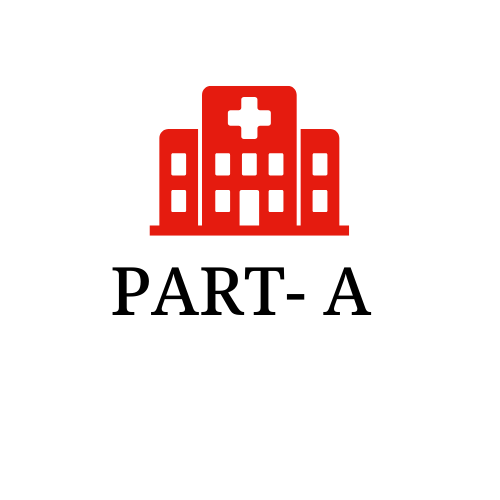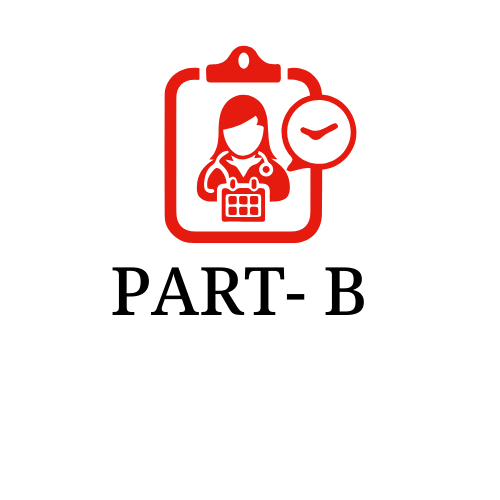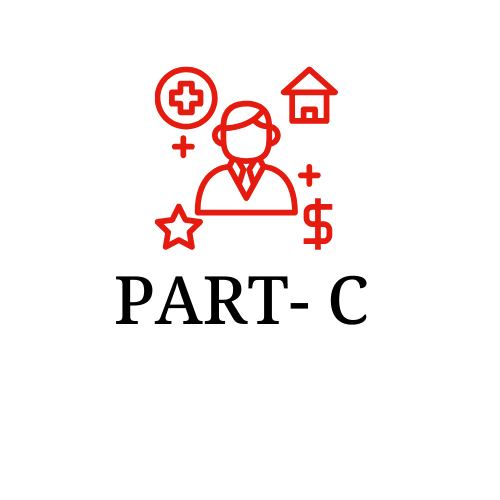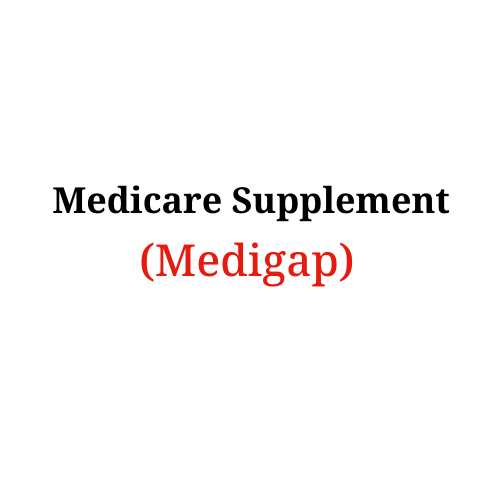Services
One-stop shop for understanding Medicare, the health insurance program for millions of Americans. Whether you’re nearing 65 or helping a loved one navigate their options, Hoover Insurance Group is here to guide you through the “why,” “what,” and “who” of Medicare.

Medicare Part A
Medicare Part A is often referred to as hospital insurance and is a core component of the United States Medicare system, which provides health coverage primarily for individuals who are 65 and older, as well as for some younger people with disabilities and those with certain health conditions.
It’s also important to understand the costs associated with Part A. Although many people do not pay a monthly premium, there are deductibles and co-payments for services. For example, there’s a deductible for each benefit period for hospital stays, and daily co-payments for extended stays in hospitals or skilled nursing facilities.
For many, understanding how and when Part A coverage applies is crucial for managing their health care needs and planning financially for potential hospitalizations or other types of care covered under this part of Medicare.
Hospital Care: This includes inpatient hospital stays, which covers a semi-private room, meals, general nursing, and medications that are part of your inpatient treatment. Part A also covers care in critical access hospitals and inpatient rehabilitation facilities.
Skilled Nursing Facility Care: After a qualifying hospital stay, Medicare Part A can cover a stay in a skilled nursing facility. Coverage includes meals, skilled nursing care, physical and occupational therapy (if needed), and other services. However, it’s important to note that it does not cover long-term or custodial care.
Hospice Care: For patients who are terminally ill and choose to receive palliative care instead of treatment for their illness, Medicare Part A covers hospice services. This includes drugs for symptom control or pain relief, medical, nursing, and social services, and other covered services as well as supplies for the terminal illness and related conditions.
Home Health Care: Part A may cover limited home health services such as intermittent skilled nursing care, physical therapy, speech-language pathology services, and continued occupational therapy, provided certain conditions are met.
Medicare Part A is funded primarily through payroll taxes paid by employees and employers, which are part of the Federal Insurance Contributions Act (FICA). Most people do not pay a premium for Part A if they or their spouse paid Medicare taxes for a certain amount of time while working; this is often called “premium-free Part A.”

Medicare Part A
Medicare Part A is often referred to as hospital insurance and is a core component of the United States Medicare system, which provides health coverage primarily for individuals who are 65 and older, as well as for some younger people with disabilities and those with certain health conditions.
Medicare Part A covers:
Hospital Care: This includes inpatient hospital stays, which covers a semi-private room, meals, general nursing, and medications that are part of your inpatient treatment. Part A also covers care in critical access hospitals and inpatient rehabilitation facilities.
Skilled Nursing Facility Care: After a qualifying hospital stay, Medicare Part A can cover a stay in a skilled nursing facility. Coverage includes meals, skilled nursing care, physical and occupational therapy (if needed), and other services. However, it’s important to note that it does not cover long-term or custodial care.
Hospice Care: For patients who are terminally ill and choose to receive palliative care instead of treatment for their illness, Medicare Part A covers hospice services. This includes drugs for symptom control or pain relief, medical, nursing, and social services, and other covered services as well as supplies for the terminal illness and related conditions.
Home Health Care: Part A may cover limited home health services such as intermittent skilled nursing care, physical therapy, speech-language pathology services, and continued occupational therapy, provided certain conditions are met.
Medicare Part A is funded primarily through payroll taxes paid by employees and employers, which are part of the Federal Insurance Contributions Act (FICA). Most people do not pay a premium for Part A if they or their spouse paid Medicare taxes for a certain amount of time while working; this is often called “premium-free Part A.”
It’s also important to understand the costs associated with Part A. Although many people do not pay a monthly premium, there are deductibles and co-payments for services. For example, there’s a deductible for each benefit period for hospital stays, and daily co-payments for extended stays in hospitals or skilled nursing facilities.
For many, understanding how and when Part A coverage applies is crucial for managing their health care needs and planning financially for potential hospitalizations or other types of care covered under this part of Medicare.

Medicare Part B
Medicare Part B is often described as medical insurance and forms an essential part of the Medicare program in the United States, designed primarily to cover services from doctors and other health care providers, outpatient care, home health care, durable medical equipment, and some preventive services for those eligible—typically individuals over 65, or younger people with certain disabilities or conditions.
Medicare Part B covers:
Doctors’ Services: This includes services from doctors and other health care providers, whether they are received in a hospital, a doctor’s office, an outpatient setting, or sometimes even at home.
Outpatient Care: Part B covers care that you receive outside of a hospital setting, such as at a clinic or a doctor’s office. This can include outpatient surgery and other necessary medical procedures.
Home Health Care: Similar to Part A, Part B covers certain types of home health care, but it is generally focused on the medical services aspect rather than any long-term or custodial care.
Durable Medical Equipment (DME): This includes items such as wheelchairs, walkers, and other equipment prescribed by a doctor for use in the home.
Preventive Services: To help prevent illness or detect health problems early, when they’re easier to treat, Part B covers many preventive services, including certain vaccines, screenings (like mammograms and colonoscopies), and counseling services (such as smoking cessation and nutritional counseling).
Mental Health Services: Part B also covers some mental health services, including outpatient counseling and therapy.
Unlike Part A, Medicare Part B requires a monthly premium, which most people pay. The premium amount can vary based on your income, with higher earners paying more. There’s also an annual deductible, after which you typically pay 20% of the Medicare-approved amount for most doctor services (including most doctor services while you’re a hospital inpatient), outpatient therapy, and durable medical equipment.
Part B is optional; however, it is highly recommended for those who need coverage beyond just hospital stays, as it significantly reduces the costs of medical care and preventive services. Enrolling in Part B as soon as you’re eligible can help avoid potential penalties that increase the premium, which are applied if you sign up later.
Overall, Medicare Part B plays a crucial role in helping manage health care costs by covering services that are essential for the treatment and management of various health conditions, providing access to necessary preventive care to maintain one’s health.
Medicare Part A covers:
Hospital Care: This includes inpatient hospital stays, which covers a semi-private room, meals, general nursing, and medications that are part of your inpatient treatment. Part A also covers care in critical access hospitals and inpatient rehabilitation facilities.
Skilled Nursing Facility Care: After a qualifying hospital stay, Medicare Part A can cover a stay in a skilled nursing facility. Coverage includes meals, skilled nursing care, physical and occupational therapy (if needed), and other services. However, it’s important to note that it does not cover long-term or custodial care.
Hospice Care: For patients who are terminally ill and choose to receive palliative care instead of treatment for their illness, Medicare Part A covers hospice services. This includes drugs for symptom control or pain relief, medical, nursing, and social services, and other covered services as well as supplies for the terminal illness and related conditions.
Home Health Care: Part A may cover limited home health services such as intermittent skilled nursing care, physical therapy, speech-language pathology services, and continued occupational therapy, provided certain conditions are met.
Medicare Part A is funded primarily through payroll taxes paid by employees and employers, which are part of the Federal Insurance Contributions Act (FICA). Most people do not pay a premium for Part A if they or their spouse paid Medicare taxes for a certain amount of time while working; this is often called “premium-free Part A.”
It’s also important to understand the costs associated with Part A. Although many people do not pay a monthly premium, there are deductibles and co-payments for services. For example, there’s a deductible for each benefit period for hospital stays, and daily co-payments for extended stays in hospitals or skilled nursing facilities.
For many, understanding how and when Part A coverage applies is crucial for managing their health care needs and planning financially for potential hospitalizations or other types of care covered under this part of Medicare.

Part C (Medicare Advantage)
Medicare Part C, also known as Medicare Advantage, is an alternative way to receive your Medicare benefits. It bundles Medicare Part A (hospital insurance), Part B (medical insurance), and usually Part D (prescription drug coverage) into one comprehensive plan. These plans are offered by private insurance companies approved by Medicare.
Medicare Part C:
All-in-One Coverage: Medicare Advantage plans provide all the benefits of Parts A and B, and most include Part D as well. Many plans offer additional benefits not covered by Original Medicare, such as dental, vision, hearing, and wellness programs.
Network Restrictions: Unlike Original Medicare, which allows beneficiaries to see any doctor or hospital that accepts Medicare, Medicare Advantage plans typically have network restrictions. This means you may need to see doctors and hospitals within the plan’s network to get the lowest out-of-pocket costs. Some plans allow you to use out-of-network providers, but usually at a higher cost.
Out-of-Pocket Costs: These plans often have different costs associated with services than Original Medicare. This can include different deductibles, copayments, and coinsurance fees. Many plans offer a cap on out-of-pocket expenses, which Original Medicare does not provide.
Types of Plans: Medicare Advantage includes several types of plans such as Health Maintenance Organizations (HMOs), Preferred Provider Organizations (PPOs), Private Fee-for-Service Plans (PFFS), and Special Needs Plans (SNPs) that cater to specific groups of people, like those with certain chronic conditions or those who are eligible for both Medicare and Medicaid.
Enrollment Periods: You can enroll in a Medicare Advantage plan when you first become eligible for Medicare. There are also designated enrollment periods each year (Annual Election Period from October 15 to December 7) during which you can switch plans or revert to Original Medicare.
Premiums: In addition to the Part B premium that you must continue to pay, Medicare Advantage plans may charge an additional monthly premium, though some plans offer a $0 premium.
Medicare Advantage plans can offer extra convenience by combining multiple types of coverage into a single plan and potentially lowering out-of-pocket costs. However, it’s important to compare plans based on your specific needs and preferences, including provider networks, drug formularies, and costs associated with the plan.

Medicare Supplement (Medigap)
Medicare Supplement Insurance, also known as Medigap, is a type of insurance sold by private companies to cover gaps in Original Medicare (Part A and Part B). It helps pay some of the health care costs that Original Medicare doesn’t cover, such as copayments, coinsurance, and deductibles.
Filling the Gaps: Medigap policies are designed to cover the “gaps” in Original Medicare coverage, such as the costs of copayments, coinsurance, and deductibles. For example, if you have a hospital stay and have already met the deductible, Medicare will cover 80% of the allowable costs, and your Medigap policy can cover the remaining 20%.
Standardized Plans: There are 10 standardized Medigap plans available in most states, identified by letters (A, B, C, D, F, G, K, L, M, N). Each plan offers a different combination of benefits, but all plans of the same letter offer the same coverage no matter which insurance company sells it. Note that as of January 1, 2020, plans C and F are not available to new Medicare enrollees but may still be available to those who were already enrolled in Medicare before that date.
Not a Standalone Coverage: To purchase a Medigap policy, you must have Medicare Part A and Part B. A Medigap policy only covers one person, so if you and your spouse both want Medigap coverage, you’ll each need to buy separate policies.
No Prescription Drug Coverage: Medigap plans sold after January 1, 2006, do not include prescription drug coverage. If you require this, you’ll need to join a Medicare Prescription Drug Plan (Part D).
Costs: The cost of Medigap policies can vary widely, depending on the plan, the area you live in, the insurance company, and when you buy the policy. Each company calculates premiums differently: they can be community-rated (the same monthly premium for all), issue-age-rated (based on your age when you buy the policy), or attained-age-rated (increasing as you age).
Guaranteed Renewable: Medigap policies are generally guaranteed renewable even if you have health problems. This means the insurance company can’t cancel your Medigap policy as long as you pay the premium.
When to Buy: The best time to buy a Medigap policy is during your Medigap Open Enrollment Period, which starts on the first day of the month in which you are both 65 or older and enrolled in Medicare Part B. During this period, you have a guaranteed issue right to buy any Medigap policy sold in your state, regardless of your health status.
Medicare Supplement Insurance can significantly ease the financial burden associated with healthcare costs not covered by Original Medicare, making it a valuable option for those seeking additional health coverage.
Medicare Part D is the prescription drug coverage component of Medicare, designed to help Medicare beneficiaries pay for prescription drugs. This part of Medicare is provided through private insurance companies that are approved by Medicare, and it is available to anyone who has either Medicare Part A or Part B.
Doctors’ Services
This includes services from doctors and other health care providers, whether they are received in a hospital, a doctor’s office, an outpatient setting, or sometimes even at home.
Outpatient Care
Part B covers care that you receive outside of a hospital setting, such as at a clinic or a doctor’s office. This can include outpatient surgery and other necessary medical procedures.
Home Health Care
Similar to Part A, Part B covers certain types of home health care, but it is generally focused on the medical services aspect rather than any long-term or custodial care.
Durable Medical Equipment (DME):
This includes items such as wheelchairs, walkers, and other equipment prescribed by a doctor for use in the home.
Mental Health Services
Part B also covers some mental health services, including outpatient counseling and therapy.

Medicare Part B
Medicare Part B is often described as medical insurance and forms an essential part of the Medicare program in the United States, designed primarily to cover services from doctors and other health care providers, outpatient care, home health care, durable medical equipment, and some preventive services for those eligible—typically individuals over 65, or younger people with certain disabilities or conditions.
Preventive Services
To help prevent illness or detect health problems early, when they’re easier to treat, Part B covers many preventive services, including certain vaccines, screenings (like mammograms and colonoscopies), and counseling services (such as smoking cessation and nutritional counseling).
Unlike Part A, Medicare Part B requires a monthly premium, which most people pay. The premium amount can vary based on your income, with higher earners paying more. There’s also an annual deductible, after which you typically pay 20% of the Medicare-approved amount for most doctor services (including most doctor services while you’re a hospital inpatient), outpatient therapy, and durable medical equipment.
Part B is optional; however, it is highly recommended for those who need coverage beyond just hospital stays, as it significantly reduces the costs of medical care and preventive services. Enrolling in Part B as soon as you’re eligible can help avoid potential penalties that increase the premium, which are applied if you sign up later.
Overall, Medicare Part B plays a crucial role in helping manage health care costs by covering services that are essential for the treatment and management of various health conditions, providing access to necessary preventive care to maintain one’s health.

Part C (Medicare Advantage)
Medicare Part C, also known as Medicare Advantage, is an alternative way to receive your Medicare benefits. It bundles Medicare Part A (hospital insurance), Part B (medical insurance), and usually Part D (prescription drug coverage) into one comprehensive plan. These plans are offered by private insurance companies approved by Medicare.
All-in-One Coverage: Medicare Advantage plans provide all the benefits of Parts A and B, and most include Part D as well. Many plans offer additional benefits not covered by Original Medicare, such as dental, vision, hearing, and wellness programs.
Network Restrictions
Unlike Original Medicare, which allows beneficiaries to see any doctor or hospital that accepts Medicare, Medicare Advantage plans typically have network restrictions. This means you may need to see doctors and hospitals within the plan’s network to get the lowest out-of-pocket costs. Some plans allow you to use out-of-network providers, but usually at a higher cost.
Out-of-Pocket Costs
These plans often have different costs associated with services than Original Medicare. This can include different deductibles, copayments, and coinsurance fees. Many plans offer a cap on out-of-pocket expenses, which Original Medicare does not provide.
Types of Plans
Medicare Advantage includes several types of plans such as Health Maintenance Organizations (HMOs), Preferred Provider Organizations (PPOs), Private Fee-for-Service Plans (PFFS), and Special Needs Plans (SNPs) that cater to specific groups of people, like those with certain chronic conditions or those who are eligible for both Medicare and Medicaid.
Enrollment Periods
Medicare Advantage includes several types of plans such as Health Maintenance Organizations (HMOs), Preferred Provider Organizations (PPOs), Private Fee-for-Service Plans (PFFS), and Special Needs Plans (SNPs) that cater to specific groups of people, like those with certain chronic conditions or those who are eligible for both Medicare and Medicaid.
Premiums
In addition to the Part B premium that you must continue to pay, Medicare Advantage plans may charge an additional monthly premium, though some plans offer a $0 premium.
Medicare Advantage plans can offer extra convenience by combining multiple types of coverage into a single plan and potentially lowering out-of-pocket costs. However, it’s important to compare plans based on your specific needs and preferences, including provider networks, drug formularies, and costs associated with the plan.
Filling the Gaps: Medigap policies are designed to cover the “gaps” in Original Medicare coverage, such as the costs of copayments, coinsurance, and deductibles. For example, if you have a hospital stay and have already met the deductible, Medicare will cover 80% of the allowable costs, and your Medigap policy can cover the remaining 20%.
Standardized Plans:
There are 10 standardized Medigap plans available in most states, identified by letters (A, B, C, D, F, G, K, L, M, N). Each plan offers a different combination of benefits, but all plans of the same letter offer the same coverage no matter which insurance company sells it. Note that as of January 1, 2020, plans C and F are not available to new Medicare enrollees but may still be available to those who were already enrolled in Medicare before that date.
Not a Standalone Coverage
To purchase a Medigap policy, you must have Medicare Part A and Part B. A Medigap policy only covers one person, so if you and your spouse both want Medigap coverage, you’ll each need to buy separate policies.
Guaranteed Renewable
Medigap policies are generally guaranteed renewable even if you have health problems. This means the insurance company can’t cancel your Medigap policy as long as you pay the premium.
When to Buy
The best time to buy a Medigap policy is during your Medigap Open Enrollment Period, which starts on the first day of the month in which you are both 65 or older and enrolled in Medicare Part B. During this period, you have a guaranteed issue right to buy any Medigap policy sold in your state, regardless of your health status.
Medicare Part D is the prescription drug coverage component of Medicare, designed to help Medicare beneficiaries pay for prescription drugs. This part of Medicare is provided through private insurance companies that are approved by Medicare, and it is available to anyone who has either Medicare Part A or Part B.

Medicare Supplement (Medigap)
Medicare Supplement Insurance, also known as Medigap, is a type of insurance sold by private companies to cover gaps in Original Medicare (Part A and Part B). It helps pay some of the health care costs that Original Medicare doesn’t cover, such as copayments, coinsurance, and deductibles.
No Prescription Drug Coverage
Medigap plans sold after January 1, 2006, do not include prescription drug coverage. If you require this, you’ll need to join a Medicare Prescription Drug Plan (Part D).
Costs
The cost of Medigap policies can vary widely, depending on the plan, the area you live in, the insurance company, and when you buy the policy. Each company calculates premiums differently: they can be community-rated (the same monthly premium for all), issue-age-rated (based on your age when you buy the policy), or attained-age-rated (increasing as you age).
Medicare Supplement Insurance can significantly ease the financial burden associated with healthcare costs not covered by Original Medicare, making it a valuable option for those seeking additional health coverage.
Medicare Part D is the prescription drug coverage component of Medicare, designed to help Medicare beneficiaries pay for prescription drugs. This part of Medicare is provided through private insurance companies that are approved by Medicare, and it is available to anyone who has either Medicare Part A or Part B.
Here’s a breakdown of what you need to know about Medicare Part D (Prescription Drug Plan)
Coverage
Plan Variations:
Part D plans vary by insurer but generally cover a wide range of prescription drugs that most people take, including brand name drugs and generics. Each plan has a formulary, which is a list of covered drugs. Plans are required to cover at least two drugs in most categories and classes, ensuring that people with different medical conditions can get the prescription drugs they need.
Tiers:
Drugs on a formulary are typically organized into different tiers, which have different costs associated. Lower tiers will generally include generic drugs with lower copayments, while higher tiers include brand name drugs with higher copayments.
Costs
Premiums:
Just like other parts of Medicare, Part D plans charge a monthly premium that varies by plan.
Deductibles and Copayments:
Some plans have a deductible that you must pay before the plan begins to pay its share of your drug costs. After meeting the deductible, you typically pay a copayment or coinsurance (a percentage of the drug cost) for each prescription.
Coverage Gap (Donut Hole):
Most Medicare drug plans have a coverage gap, often called the “donut hole”. This means there’s a temporary limit on what the drug plan will cover for drugs. In 2023, once you and your plan have spent $4,660 on covered drugs, you’re in the donut hole. While in the donut hole, you’ll pay 25% of the cost for brand name and generic drugs. After your yearly out-of-pocket drug costs reach $7,400, you leave the donut hole and enter catastrophic coverage, where you only pay a small copayment or coinsurance for covered drugs for the rest of the year.
